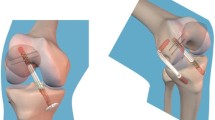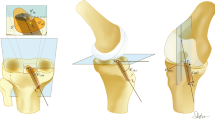Abstract
The objective of the study was to compare prospectively short-term and mid-term results after ACL reconstruction with special focus on changes in instrumented knee laxity.
Methods: The original study group included prospectively 58 patients who underwent arthroscopically assisted ACL reconstruction with BPTB graft in a two-tunnel technique between 1991 and 1993. Seven patients were lost to follow-up, leaving 51 patients for a first follow-up at 6 months and a second follow-up at 3–6 years (mean 4.3 years). Clinical results were evaluated by means of the Lysholm score and the IKDC score. Laxity was assessed using a KT-1000 arthrometer applying an 89 N anterior load in 20° of flexion. Increased laxity was defined as a 3 mm increase in AP translation between the first and the second follow-up.
Results: At mid-term follow-up pivot shift was negative in 86% of cases. IKDC score: normal=28%, nearly normal=44%, abnormal=24%, severely abnormal=4%. KT-1000: <3 mm=68%, 3–5 mm=24%, >5 mm=8%. The mean KT-1000 side-to-side difference was 1.08 (0.17) mm at 6 months and 2.01 (0.29) mm at 3–6 years. The difference was statistically significant (P<0.005). According to the defined criteria, seven patients had increased laxity at the second follow-up, suggesting a malfunction of the graft due to stretch-out or injury. In this subgroup the mean KT-1000 measurements were 0.86 (0.26) mm at the first follow-up and 5.93 (0.54) mm at the second follow-up. In five of these patients, a malposition of the tunnels was identified as a possible cause. In the remaining group, KT-1000 measurements did not differ significantly between the first and the second follow-up [1.12 (0.20) mm versus 1.37 (0.21) mm].
Conclusions: Increase in AP laxity occurred in 14% of our cases between the first and the second follow-up. In most of these cases increased laxity was due to inadequate surgical technique, especially malposition of bony tunnels. If tunnel position was correct, there was no evidence for elongation of grafts over time as a general principle.
Similar content being viewed by others
Author information
Authors and Affiliations
Additional information
Electronic Publication
Rights and permissions
About this article
Cite this article
Rupp, S., Müller, B. & Seil, R. Knee laxity after ACL reconstruction with a BPTB graft. Knee Surg Sports Traumatol Art 9, 72–76 (2001). https://doi.org/10.1007/s001670000177
Received:
Accepted:
Published:
Issue Date:
DOI: https://doi.org/10.1007/s001670000177




